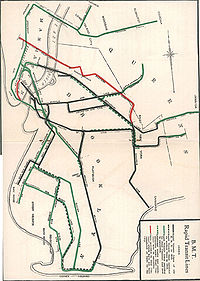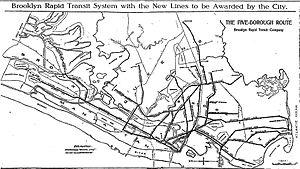- Dual Contracts
-
The Dual Contracts of 1913, also known as the Dual Subway System, were contracts for the construction and/or rehabilitation and operation of rapid transit lines in the City of New York. The majority of the lines of the present-day New York Subway were built or reconstructed under these contracts. The contracts were "dual," in that they were signed between the City and two separate private companies.
Contents
Background
Contract 3 was signed between the City and the IRT, operator of the original subway line in New York City. Contract 4 was signed between the City and the Municipal Railway Company, a subsidiary of the BRT (later BMT), formed especially for the purpose of contracting with the city for construction of the lines. Contracts 1 and 2 were the original subway contracts between the City and the IRT for the first subway in New York. These contracts predated the Dual Contracts.
Under the terms of Contracts 3 and 4, the city would build new subway and elevated lines, and rehabilitate and expand certain existing elevated lines, and lease them to the private companies for operation. The cost would be borne more-or-less equally by the City and the companies. The City's contribution was in cash raised by bond offerings, while the companies' contributions were variously by supplying cash, facilities and equipment to run the lines.
The contract negotiations were long and sometimes acrimonious. For instance, when the IRT was reluctant (if not totally opposed) to the BRT's proposed access to Midtown Manhattan via the Broadway Line, the city and state negotiators immediately offered the BRT all of the lines under proposal - including such obvious IRT tie-ins such as the upper Lexington Avenue Line, and both lines in Queens. The IRT quickly gave in to the 'invasion' of Midtown Manhattan by the BRT.
The assignment of the proposed lines in Queens proved to be an imposition on both companies. Instead of one company enjoying a monopoly in that borough, both proposed lines — a short line to Astoria, and a longer line reaching initially to Corona, and eventually to Flushing — were assigned to both companies, to be operated in what was called "joint service." The lines would start from a huge station called Queensborough Plaza. The IRT would access the station from both the 1907 Steinway Tunnel and an extension of the Second Avenue Elevated from Manhattan over the Queensborough Bridge. The BRT would feed the Queens lines from a new tunnel from 60th Street in Manhattan. Technically the line was under IRT 'ownership', but the BRT/BMT was granted trackage rights in perpetuity, essentially making it theirs also.
The BRT had a big disadvantage, as both Queens lines were built to IRT specifications. This meant that IRT passengers would have a one-seat ride to Manhattan destinations, whereas BRT passengers had to make a change at Queensborough Plaza. This came to be important when service was extended for the 1939 World's Fair, as the IRT was able to offer direct express trains from Manhattan, and the BRT was not. This practice lasted well into the municipal ownership of the lines, and was not ended until 1949. Both companies would share in the revenues from this service. To facilitate this arrangement originally, extra long platforms were constructed along both Queens routes, so separate fare controls/boarding areas could be established. This quickly turned out to be operationally unworkable, so eventually a proportionate formula was worked out. The bonus legacy of this construction was that the IRT was able to operate 11-car trains on this line, and when the BMT took over the Astoria Line, minimal work had to done to accommodate 10-car BMT units.
Several provisions were imposed on the companies, which eventually led to their downfall and consolidation into City ownership in 1940:
- The fare was limited to five cents, and this led to financial troubles for the two companies after post-World War I inflation.
- The City had the right to "recapture" any of the lines it built, and run them as its own.
- The City was to share in the profits.
IRT lines
The following lines were built under the Dual Contracts for the IRT:
- Astoria Line and Flushing Line
- Broadway – Seventh Avenue Line south of Times Square – 42nd Street, including the Brooklyn Branch
- Lexington Avenue Line north of Grand Central – 42nd Street
- Jerome Avenue Line
- Ninth Avenue Line from 155th Street to the Jerome Avenue Line
- Pelham Line
- White Plains Road Line north of 177th Street (present-day Tremont Avenue)
- Eastern Parkway Line beyond Atlantic Avenue
- Nostrand Avenue Line
- New Lots Line
The following lines were rebuilt with extra tracks:
- Ninth Avenue Line from 125th Street to 155th Street (one new track)
BMT lines
All Manhattan and Queens BMT lines were built under the Dual Contracts, as were all subway and some elevated lines in Brooklyn.
Lines and line segments built new
- 14th Street Eastern Line west of Broadway Junction
- Astoria Line and Flushing Line east of Queensboro Plaza (trackage rights over IRT)
- Broadway Line
- Brighton Beach Line between DeKalb Avenue and Prospect Park
- Fourth Avenue Line
- Fulton Street Line east of Grant Avenue
- Jamaica Line east of Cypress Hills
- Manhattan Bridge tracks and approaches
- Nassau Street Line between Chambers Street to a merge with the Montague Street Tunnel to Brooklyn
Grade-separated rights-of-way built to replace surface railroads
- Brighton Beach Line between Neptune Avenue (south of Sheepshead Bay) and Coney Island – Stillwell Avenue. Four-track elevated structure.
- Culver Line between Ninth Avenue and West Eighth Street (merge with Brighton Beach Line). Three-track elevated structure.
- Myrtle Avenue Line east of Myrtle–Wyckoff Avenues. Two-track elevated structure.
- Sea Beach Line from Fourth Avenue Subway to 86th Street. Four-track open cut.
- West End Line between Ninth Avenue and Bay 50th Street. Three-track elevated structure.
Existing rights-of-way rehabilitated and expanded
- Brighton Beach Line from Prospect Park to Church Avenue. Existing open cut widened and expanded from two to four tracks.
- Jamaica Line from merge with line from Marcy Avenue to Broadway Junction. Elevated line expanded from two to three tracks.
- Myrtle Avenue Line from Broadway–Myrtle to Myrtle–Wyckoff Avenues, including track connection to Jamaica Line. Elevated structure expanded from two to three tracks.
- Fulton Street Line from Nostrand Avenue to east of split from Canarsie Line at Pitkin Avenue. Two track elevated expanded to three tracks and new flying junction complex with six tracks replaced two tracks between former Manhattan Junction in East New York and Pitkin Avenue. This portion gave the Canarsie Line two dedicated tracks.
External links
New York City Subway Services 


Unused
or defunct8 · 9 · AA · BB · CC · EE (8 Avenue) · EE (Broadway) · GG · H · HH (Court Street) · HH (Rockaway Park) · JJ · K (Jamaica) · K (8 Avenue) · KK · LL · MJ · NX · P · QB · QJ · QT · RJ · RR · T · TT · U · V · W · X · Y · JFK Express
ShuttlesBMTCapital projects Divisions A Division (IRT) · B Division (BMT · IND)Stations BoroughsThe Bronx · Brooklyn · Manhattan · QueensTypesOther lists Miscellaneous Staten Island Railway · Automation · Chaining · History · Fares · MetroCard · Nomenclature · Rolling stock · Proposed expansion (1929–1940)Categories:- New York City Subway history
- Brooklyn-Manhattan Transit Corporation
- Interborough Rapid Transit Company
Wikimedia Foundation. 2010.



